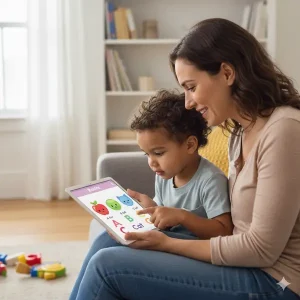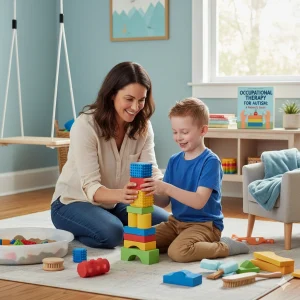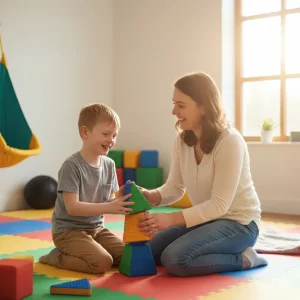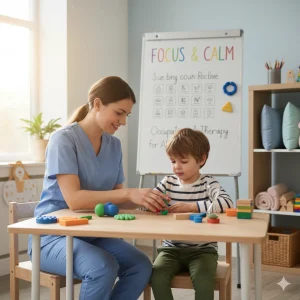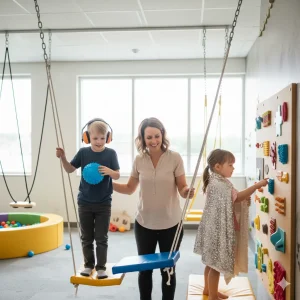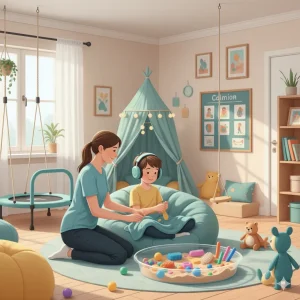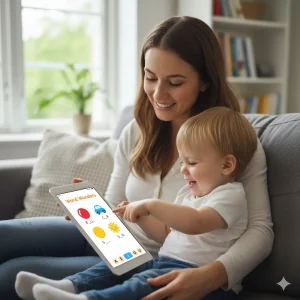What Sitaare Zameen Par Teaches About Neurodiversity
By Wellness Hub
Last Updated: June 21, 2025
What happens when a Bollywood film puts real neurodivergent individuals at the center of its story? Sitaare Zameen Par (2025), starring Aamir Khan, does exactly that—and it hits home for every Indian parent raising a child with special needs.
This inspiring sports drama follows a struggling basketball coach who trains a team of young adults with intellectual and developmental disabilities. The film doesn’t use stereotypes. It casts real neurodiverse actors similar to how inclusive learning materials for special needs reflect authentic experiences
Through every scene, Sitaare Zameen Par teaches us that inclusion isn’t charity—it’s a right. For Indian parents navigating learning differences, autism, or developmental delays, this film offers more than entertainment. It reflects your reality, your hopes, and your questions.
In this blog, let’s explore what Sitaare Zameen Par can teach us about neurodiversity—and how it helps break the stigma one scene at a time.
Read Sudha Murty’s inspiring review of Sitaare Zameen Par and see why she calls it a breakthrough moment for disability representation in Indian cinema.
What is Neurodiversity
Neurodiversity means that every brain works differently. Some children learn, think, feel, or communicate in ways that don’t match what we often call “typical.” That’s not a flaw. It’s simply a different way of being.
For parents, understanding neurodiversity starts with recognizing that these differences are natural. Your child may not fit into every standard box—and that’s okay. Neurodiverse children bring unique strengths, creativity, and ways of seeing the world.
Some common types of neurodiverse conditions include:
- Autism Spectrum Disorder (ASD) – Children may struggle with social interactions or prefer routines, but often show incredible focus or memory.
- Attention-Deficit/Hyperactivity Disorder (ADHD) – Kids with ADHD may act impulsively or find it hard to sit still, but they often think quickly and creatively.
- Learning Differences – Some children may have trouble with reading, writing, or math, but still shine in art, music, or hands-on activities.
- Intellectual Disabilities – These children may take longer to develop certain skills, but they can still learn and thrive with the right support.
Sitaare Zameen Par highlights a range of these conditions through its cast. The characters in the film show how children and young adults with neurodevelopmental differences face challenges—and how they rise beyond them when people believe in their potential. Instead of focusing on diagnosis, the film invites parents to see the whole child, not just a label.
When you understand the neurodiversity meaning for parents, you begin to see the beauty in difference. And once that shift happens, your child feels safe to grow.
How Sitaare Zameen Par Represents Neurodiverse Characters
Sitaare Zameen Par stands out not just for its story but for how it brings that story to life—with real actors who have intellectual disabilities. This decision alone makes a bold and necessary statement. It shows that inclusive casting in Indian movies is not only possible, but powerful.
The film features ten neurodiverse debutants in central roles. They don’t play side characters or silent supporters. They are the heart of the story. Their performances feel real, not rehearsed. Their presence on screen brings authenticity that no trained actor could replicate. Each character comes with their own quirks, emotions, and abilities—and the film allows them space to shine.
What sets Sitaare Zameen Par apart is how it treats these characters. It doesn’t ask the audience to pity them. Instead, it celebrates their spirit. These young players face challenges, but they also crack jokes, build friendships, and chase dreams. The film uses humor and honesty to show their struggles without reducing them to their disabilities. It proves that positive disability representation in Bollywood can be uplifting and entertaining—without being preachy.
Older films often missed this mark. They either ignored neurodiverse characters or reduced them to stereotypes—helpless, silent, or tragic. Some past roles treated disability as a plot device or a sympathy trigger. Sitaare Zameen Par flips that narrative. It doesn’t box its characters into cliches. It gives them agency, voice, and presence.
By showing neurodiverse individuals as capable and confident, the film sets a new standard for Indian cinema. It speaks directly to families, schools, and society at large: inclusion works when we give everyone a chance to be seen as they are.
Lessons for Indian Parents Watching the Film
Sitaare Zameen Par tells the story of young adults with intellectual disabilities. But the lessons it offers speak directly to Indian parents. The film challenges what society sees as “normal” and shows how much potential lies beneath assumptions and labels.
1. Emotional Intelligence Begins with Acceptance
Gulshan, the basketball coach, walks in with arrogance. He sees the players as incapable and views his assignment as punishment. But as he spends time with them, he notices their effort, humor, loyalty, and raw talent. He doesn’t teach them at first—they teach him how to listen without judgment.
Indian parents often feel pressure to compare, correct, or “fix” their child’s differences. The film reminds us that emotional intelligence starts with one thing: understanding behavior beyond labels. You don’t need to have all the answers. You need to observe, pause, and connect with your child as they are.
2. Inclusion Goes Beyond the Classroom
Inclusion is not just a school policy. It’s a way of thinking. The players in Sitaare Zameen Par become confident, not because they got special treatment—but because they got a chance to play, participate, and belong.
Indian parents can promote inclusion by giving their child opportunities to engage—whether in sports, community spaces, or family gatherings. Don’t limit your child’s world based on others’ expectations. Let them try, fail, learn, and grow. Every child, whether neurotypical or neurodiverse, deserves a space to shine.
3. The Coach’s Journey Mirrors the Parent’s Journey
Gulshan didn’t change overnight. He struggled, resisted, and questioned himself. But once he started seeing the team with fresh eyes, he discovered a new version of himself too. This mirrors the journey many Indian parents go through when raising a neurodiverse child.
Change begins not with textbooks or therapies—but with mindset. The film shows that supporting special needs isn’t about becoming an expert in psychology. It’s about staying open, showing up every day, and being willing to grow alongside your child.
Why Representation in Media Shapes Public Perception
Movies do more than entertain us—they shape the way we see the world. For many people, especially in India, films serve as a first introduction to topics that schools and families often overlook. This is especially true when it comes to disability awareness and neurodiversity.
In 2007, Taare Zameen Par changed the conversation around learning difficulties. Aamir Khan’s portrayal of a compassionate teacher and the story of Ishaan, a child with dyslexia, sparked national awareness. Schools started talking about learning disorders. Parents began to look deeper when their children struggled in class. That film made a lasting impact because it didn’t just show dyslexia—it made audiences feel the emotional journey of a misunderstood child.
Now, in 2025, Sitaare Zameen Par carries that legacy forward. But this time, it shifts the focus to adults with intellectual disabilities. The story follows a disgraced basketball coach who ends up training a team of players with special needs. These are not children, and the film doesn’t treat them like helpless individuals. It shows them as capable adults—each with a unique personality, strong emotions, and dreams worth fighting for.
This kind of representation matters. It breaks old stereotypes that often label neurodivergent people as dependent or incapable. Instead of pity, the film offers respect. It highlights how inclusion works—not by lowering standards, but by changing mindsets.
When Bollywood brings stories like these to the mainstream, it educates millions. It builds empathy. It challenges outdated ideas. That’s the power of films that educate about neurodiversity. When families watch Sitaare Zameen Par, they don’t just see a sports drama—they see the dignity of difference.
Representation on screen influences how we treat people in real life. If movies continue to tell authentic stories, especially about disability, society will keep moving toward empathy, acceptance, and inclusion.
Real-World Takeaways for Home and School Life
Sitaare Zameen Par opens more than just conversations—it opens hearts. While the story centers around a team of young adults with intellectual disabilities, its message resonates far beyond the basketball court. It creates a space for families and educators to reflect on how they see, treat, and support neurodivergent individuals in daily life.
Parents can use this film as a way to teach empathy at home. Siblings begin to see the value of patience. Teachers may rethink how they respond to behaviors in the classroom. When a character in the movie struggles but keeps trying, it offers a natural moment to say, “See how support makes a difference?”
This movie works well as a family activity. Watch it together. Pause when something emotional happens. Ask your child or teenager how they felt. These conversations build emotional literacy and normalize the idea that brains can work differently—and that’s okay.
For educators or therapists, the film provides powerful themes that align with Individualized Education Program (IEP) goals. It highlights self-worth, social inclusion, and teamwork—elements that therapy often aims to strengthen. Use scenes from the film as discussion points during group sessions or even in school assemblies. It’s a creative way to introduce neurodiversity education at home and school.
Using movies to talk about disabilities doesn’t need to feel heavy or complicated. Films like Sitaare Zameen Par do the heavy lifting—your role is to connect the dots and guide the conversation.
Supporting Neurodivergent Children: What Parents Can Do Next
Parents often feel overwhelmed when they notice their child processes the world differently. But understanding neurodiversity isn’t about “fixing” a child—it’s about recognizing their strengths and helping them thrive in their own way. The film Sitaare Zameen Par reminds us that everyone learns and expresses themselves differently, and support starts with acceptance.
1. Early Identification and Intervention Matter
The earlier a parent notices signs of developmental differences—like delays in speech, motor coordination, or social interaction—the better. Early identification allows children to receive support when their brains are still rapidly developing. Intervention during these formative years builds better communication, emotional regulation, and independence.
Screenings by developmental pediatricians or psychologists help clarify if a child might benefit from speech therapy, occupational therapy, or behavioral support. It’s not about labels—it’s about giving the child the tools they need to navigate everyday life confidently.
2. Focus on Strengths, Not Just Challenges
Every neurodivergent child brings a unique perspective to the world. Some may have intense focus, creativity, or a strong sense of empathy. Parents should observe what their child enjoys and where they naturally excel. Supporting these strengths builds self-esteem and reduces frustration for both the child and the family.
Rather than comparing a child’s milestones to peers, parents can create a learning environment that respects the child’s pace and style. This mindset shift—from “correction” to “connection”—opens space for genuine growth.
3. Explore Support Systems That Work for Your Family
In India, awareness around neurodiversity is growing, but many parents still feel unsure about where to begin. Fortunately, several resources are now available to guide families through this journey.
Speech therapy and occupational therapy can help children improve communication, daily routines, and social interactions. Counseling also provides emotional support—not just for the child, but for parents who may struggle with stress or self-doubt.
The Wellness Hub offers a wide range of evidence-based tools: home-based therapy activities, flashcards, conversation cards, and structured therapy programs. These resources support families who prefer to guide their child’s development from the comfort of home, with the flexibility that fits into their routines.
Whether you’re just starting out or looking for better ways to support your child’s needs, staying informed and connected to supportive networks makes a real difference.
Where Parents Can Turn for Support: The Role of Wellness Hub
Understanding neurodiversity is only the beginning. Parents often ask, “What do I do next?” That’s where guidance becomes crucial—especially when navigating learning differences, communication challenges, or behavioral concerns. One place offering this kind of support is Wellness Hub, a platform built for families raising neurodivergent children, teens, and adults.
What makes Wellness Hub helpful is its focus on practical, evidence-based tools. The platform doesn’t just talk about inclusion—it supports it through expert-led speech therapy, occupational therapy, and social skills training. Whether a parent needs help identifying signs of communication delays or wants strategies for building confidence in their child, Wellness Hub serves as a knowledge base and support system.
Families can also find interactive resources like therapy flashcards, behavior tools, and conversation cards—all designed to make learning and bonding more engaging. These resources help bridge the gap between home, school, and therapy.
More importantly, Wellness Hub acknowledges the emotional journey of parenting a neurodivergent child. It provides insights in a language parents understand and tools they can use right away—without feeling overwhelmed or judged.
Related Films and Resources for Parents
Sitaare Zameen Par (2025) draws inspiration from the Spanish film Champions (2018). While Champions used comedy to explore inclusion, Sitaare Zameen Par adds emotional depth and cultural nuance to the same idea. Both films show that people with intellectual and developmental disabilities—whether children or adults—can thrive when society embraces them with empathy.
These films don’t preach. They help you feel, understand, and reflect. If you’re a parent looking to explore more meaningful cinema about neurodiversity, here are some powerful films worth watching with your family
Best Films on Neurodiversity and Special Needs Awareness
| Film Title | Language | What It Teaches | Suitable For |
|---|---|---|---|
| Champions (2018) | Spanish | Inclusion through sports, breaking societal labels | Parents, teens |
| Sitaare Zameen Par (2025) | Hindi | Respecting adults with intellectual disabilities in India | Parents, families |
| Taare Zameen Par (2007) | Hindi | Understanding learning differences like dyslexia | Parents, educators |
| The Reason I Jump (2020) | English | Inside the mind of non-speaking autistic individuals | Parents, therapists |
| My Name Is Khan (2010) | Hindi | Living with Asperger’s syndrome, resilience and acceptance | Parents, teens |
| Wonder (2017) | English | Facial difference, bullying, empathy, and inclusion | Parents, children |
| The Peanut Butter Falcon (2019) | English | Independence and dreams of a man with Down syndrome | Families, young adults |
| Barfi! (2012) | Hindi | Non-verbal autism and emotional connection | Parents, couples |
Each film explores different aspects of neurodiversity—whether it’s communication challenges, social acceptance, or self-worth. These movies encourage parents to look beyond diagnoses and labels, and instead focus on understanding and supporting the individual behind the condition.
When you watch these stories together as a family, you open up safe, important conversations—without lectures, without judgment. And that’s where true awareness begins.
Final Thoughts: The Power of Representation and Hope
Sitaare Zameen Par tells a story we don’t see often in Indian cinema. It doesn’t focus on children—it follows adults with intellectual disabilities. But the message reaches far beyond the basketball court.
The film shows how cinema builds empathy. It gives space to people who often remain invisible. It reminds us that inclusion isn’t just an idea—it’s something we must practice in everyday life.
If you’re a parent, this is the moment to reflect. Think about how you talk about disability. Think about the values your child learns from you. Stand up for empathy. Advocate for inclusion. Let this film spark real conversations at home.
Because in parenting, what you believe shapes how your child sees the world. And in that world, every mind matters.
Looking for resources, therapy, or expert guidance tailored for your child?
Explore online speech therapy, autism tools, and home-based solutions at Wellness Hub.
Frequently Asked Questions
1. What is the main message of Sitaare Zameen Par (2025)?
Sitaare Zameen Par highlights the importance of inclusion, dignity, and respect for individuals with intellectual and developmental disabilities. The film emphasizes that neurodiverse individuals can thrive with the right support and understanding.
2. Is Sitaare Zameen Par based on a true story?
The movie is a licensed adaptation of the Spanish film Champions (2018), which was inspired by a real basketball team composed of people with intellectual disabilities.
3. Who are the neurodiverse characters in Sitaare Zameen Par?
The film features 10 debutant actors with real-life intellectual and developmental disabilities. These characters form the basketball team that Aamir Khan’s character trains.
4. What does neurodiversity mean in simple terms?
Neurodiversity refers to the idea that brain differences—like autism, ADHD, or learning disabilities—are natural variations of the human experience, not disorders that need to be fixed.
5. How does Sitaare Zameen Par support neurodiversity awareness?
The film challenges stereotypes by portraying neurodivergent individuals as capable, empathetic, and deserving of opportunity. It helps audiences, especially parents, rethink what inclusion truly means.
6. Can parents use this movie to teach their children about inclusion?
Yes. Sitaare Zameen Par works well as a family film that opens discussions about empathy, acceptance, and how to treat people who think or behave differently.
7. Is the movie focused on children with disabilities?
No. Unlike Taare Zameen Par, this film focuses on young adults with intellectual disabilities, offering a new perspective on inclusion and late-adolescent neurodiversity.
8. How can Indian parents support neurodivergent children at home?
Parents can support neurodivergent children by encouraging strengths, seeking early intervention, using visual tools, and creating a home environment that values communication and patience.
9. Why is representation of disabilities important in Indian cinema?
Representation helps normalize neurodiversity in society. It challenges stigma, educates families, and fosters empathy in both children and adults.
10. Where can parents find help for neurodiverse children in India?
Platforms like Wellness Hub offer speech therapy, occupational therapy, and home-based learning resources to support parents of neurodivergent children and teens.
Book your Free Consultation Today
Parent/Caregiver Info:
Client’s Details:
* Error Message
